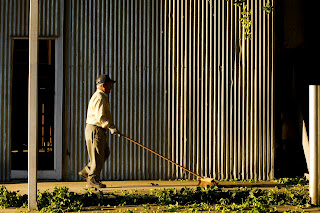
Sometimes we face problems like the one below, where there are too many hops for the conveyor to handle... if this is the worst thing that happens during the day, we are happy. Honestly though if this really does happen it causes a lot of problems because the machine will back up, chains can fall off, motors will overheat, and belts will break. A watchful eye on the amount of hops moving through the machine is a key to a successful day. We control this flow by changing the rate at which the vines are pulled into the machine. Usually this is somewhere between 18-24 vines per minute.

Trash is the second way out of the machine. A series of paddled chains carry the trash to its harvest resting place, a very large ever growing pile. This photo was from the second day of harvest. We are not almost thirty days in and the piles are very large now.

View from the far side of the pile.

This view gives glimpse of what the wooden paddles on the chain look like. They are spaced about 18 inches apart on the chain. The trash can be seen floating down. Leaves, stems, and coir.


















